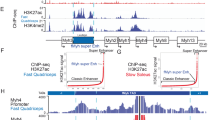Abstract
THE human muscle determination factor myf5, like MyoD (ref. 1) and other members of the family of skeletal muscle-specific regulatory proteins2–7, contains a highly conserved putative helix–loop–helix domain8. In MyoD this motif is required for the initiation of myogenesis in C3H mouse 10T1/2 fibroblasts9 and other non-muscle cells10 as well as for transcriptional activation of muscle genes. High affinity DNA binding of MyoD to regulatory DNA elements in muscle genes11,12 requires the formation of heterodimers with ubiquitous helix–loop–helix proteins such as E12 or E47 (refs 13, 14). To investigate the potential of myf5 as a transcription factor, we have fused the GAL4 DNA-binding domain to various parts of the myf5 protein and analysed the transactivation of a GAL4 reporter plasmid. Here we report that myf5 contains an intrinsic transcriptional activation domain which is distinct from the helix–loop–helix motif. The predominant trans-activating effect is associated with the C-terminal half of the myf5 molecule. High-affinity sequence-specific DNA binding of myf5 also requires hetero-oligomeric association with the enhancer-binding protein E12 to confer muscle-specific transactivation.
This is a preview of subscription content, access via your institution
Access options
Subscribe to this journal
Receive 51 print issues and online access
$199.00 per year
only $3.90 per issue
Buy this article
- Purchase on Springer Link
- Instant access to full article PDF
Prices may be subject to local taxes which are calculated during checkout
Similar content being viewed by others
References
Davis, R. L., Weintraub, H. & Lassar, A. B. Cell 51, 987–1000 (1987).
Wright, W. E., Sassoon, D. A. & Lin, V. K. Cell 56, 607–617 (1989).
Edmondson, D. G. & Olson, E. N. Genes Dev. 3, 628–640 (1989).
Braun, T. et al. EMBO J. 8, 3617–3625 (1989).
Rhodes, S. J. & Konieczny, S. Genes Dev. 3, 2050–2061 (1989).
Braun, T., Bober, E., Winter, B., Rosentnal, N. & Arnold, H. H. EMBO J. 9, 821–831 (1990).
Miner, J. H. & Wold, B. Proc. natn. Acad. Sci. U.S.A. 87, 1089–1093 (1990).
Braun, T., Buschhausen-Denker, G., Tannich, E. & Arnold, H. H. EMBO J. 8, 701–709 (1989).
Tapscott, S. J. et al. Science 242, 405–411 (1988).
Weintraub, H. et al. Proc. natn. Acad. Sci. U.S.A. 86, 5434–5438 (1989).
Lassar, A. et al. Cell 58, 823–831 (1989).
Donoghue, M. et al. Genes Dev. 2, 1779–1790 (1988).
Murre, C., McCaw, P. S. & Baltimore, D. Cell 56, 777–783 (1989).
Murre, C. et al. Cell 58, 537–544 (1989).
Schubert, D. et al. J. Cell Biol. 61, 398–413 (1974).
Davis, R. L. et al. Cell 60, 733–746 (1990).
Webster, N., Jin, J. R., Green, S., Hollis, M. & Chambon, P. Cell 52, 169–178 (1988).
Henthorn, P., Kiledjian, M. & Kadesch, T. Science 247, 467–470 (1990).
Brennan, T. J. & Olson, E. N. Genes Dev. 4, 582–595 (1990).
Thayer, M. J. et al. Cell 58, 241–248 (1989).
Harland, R. & Weintraub, H. J. Cell Biol. 101, 1094–1099 (1985).
Edlund, T. et al. Science 230, 912–916 (1985).
Braun, T. et al. Molec. cell. Biol. 9, 2513–2525 (1989).
Author information
Authors and Affiliations
Rights and permissions
About this article
Cite this article
Braun, T., Winter, B., Bober, E. et al. Transcriptional activation domain of the muscle-specific gene-regulatory protein myf5. Nature 346, 663–665 (1990). https://doi.org/10.1038/346663a0
Received:
Accepted:
Issue Date:
DOI: https://doi.org/10.1038/346663a0
This article is cited by
-
Effect of the g.–723G→T Polymorphism in the Bovine Myogenic Factor 5 (Myf5) Gene Promoter Region on Gene Transcript Level in the Longissimus Dorsi Muscle and on Meat Traits of Polish Holstein-Friesian Cattle
Biochemical Genetics (2010)
-
Developing skeletal muscle cells express functional muscarinic acetylcholine receptors coupled to different intracellular signaling systems
British Journal of Pharmacology (2005)
-
NSCL-1 and NSCL-2 synergistically determine the fate of GnRH-1 neurons and control necdin gene expression
The EMBO Journal (2004)
Comments
By submitting a comment you agree to abide by our Terms and Community Guidelines. If you find something abusive or that does not comply with our terms or guidelines please flag it as inappropriate.



